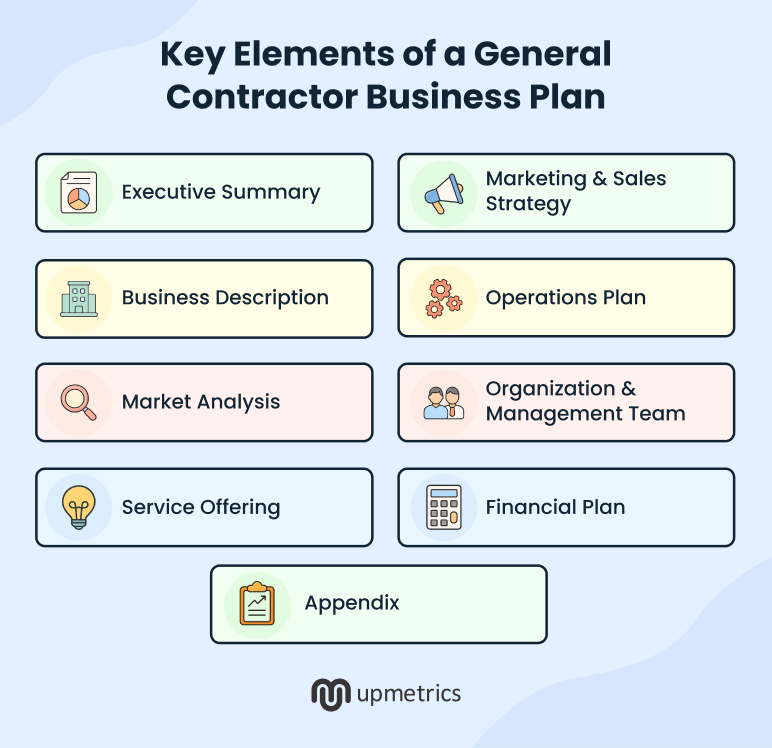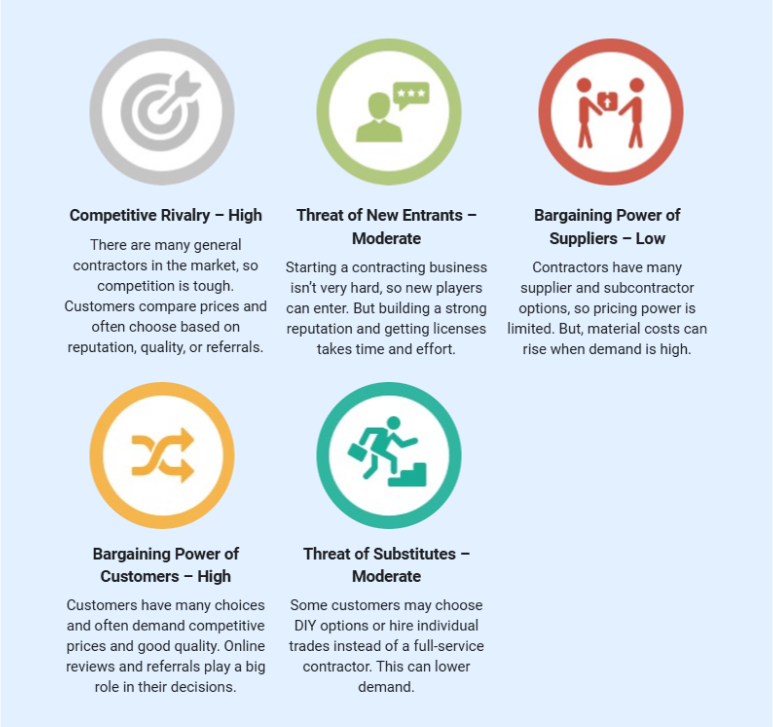You’ve got the skills, the tools, and maybe even a few projects lined up, but turning it into a successful contracting business isn’t always simple. Without a solid plan, it’s hard to deal with issues like managing clients, sticking to tight project budgets, or maintaining a steady flow of work.
That’s why we’ve built this general contractor business plan template to help you create a comprehensive, well-organized business plan.
Download now and easily map out your goals, plan finances, and show credibility to lenders or partners. This will let you focus on building a profitable and sustainable business.
Keep reading for how to write a plan that’s solid, professional, and ready for real results.
How to write a general contractor business plan?
Writing a business plan can feel like a big task, but breaking it into simple sections makes it manageable. Each part has a clear role in helping your business grow and stand out.
Here’s how to make your general contractor business plan step-by-step:

1. Executive Summary
The executive summary is a quick overview of your general contractor business. It tells readers the most important details before they get into the full plan, like a short, clear pitch for your business.
Although it appears first in your plan, it’s best to write this section last. By doing so, you can outline the key aspects of each section.
When planning your executive summary, make sure you answer:
- What is the registered name of your business, and where is it located?
- What type of work do you do (home remodels, commercial construction, new home construction, etc)?
- What makes your services better or different from other contractors in your area?
- Who are your typical customers (residential homeowners, developers, small businesses, property managers)?
- How will you find and win projects? (referrals, online advertising, partnerships with realtors, etc.)
- What is your revenue forecast, and when do you expect to break even?
- Will you require funding, and how much will it be, and how will you utilize it (equipment, payroll, or materials, etc.)?
A strong executive summary should give readers confidence in your business’s potential to achieve success. So, keep it clear, concise, and engaging so it captures attention and motivates them to read the full plan.
Say goodbye to boring templates
Build your business plan faster and easier with AI
Plans starting from $14/month

2. Business Description
The business description section explains the basics of your general contractor company in more detail. It gives readers a clear picture of who you are, what you do, and where you’re headed.
Here’s what you should include in this section:
Business name and location
Write your general contractor business name and where it’s based. Mention if you operate from a home office, a dedicated office space, or a warehouse. If you serve multiple regions or areas, list them.
Legal structure
Explain the legal structure of your business, whether it’s a sole proprietorship, partnership, LLC, or corporation. This detail not only defines your liability and taxation but also shows that your business is formally established.
Mission & vision
Your mission should explain why your business exists, and your vision paints a picture of where you’re headed.
For example, your vision could be: “To become the go-to general contractor for residential and small commercial projects in Dallas–Fort Worth, Texas.”
Company background
Provide the brief history of your company. In case you have earlier experience in construction, include how long you have been active in the industry, the projects undertaken, and any special licenses or certifications that you have.
If you’re new, highlight your skills, training, and relationships with subcontractors and suppliers that will help you succeed.
Future goals
Once you’ve set the foundation, think about where you want the business to go next. Goals help connect your current position with your long-term vision. Keep them simple by splitting into two categories:
- Short-term goals (first 12 months): Build a strong client base in the region, complete at least 10 projects, launch a professional website, and form partnerships with key suppliers.
- Long-term goals (3–5 years): Grow into a larger commercial project player, hire a permanent team of project managers, and increase annual revenue by 30% or more.
Overall, keep this section straightforward and professional. By the end, readers should clearly understand what your business does.
3. Market Analysis
The market analysis section shows that you understand the construction industry better and know who your target customers and primary competitors are.
Start by describing the general contracting market within residential, commercial, and infrastructure construction.
Cite reputable sources of data to point out how the market is expanding, what the major drivers are (urbanization, infrastructure spending, housing demand, etc.), and how it provides business opportunities to contractors.
For instance, you can mention like:
“The U.S. construction market is estimated to grow up to $2.24 trillion by 2027, and is also likely to continue its consistent growth based on housing, infrastructure initiatives, as well as commercial jobs.”
Next, describe your primary customers. For example, are you focusing on homeowners needing renovations, developers managing multi-unit housing projects, or businesses requiring office build-outs?
To make it more relatable, you can even create a simple buyer persona, for instance, instead of just saying ‘homeowners,’ describe someone like Sarah, a 38-year-old professional who wants to remodel her kitchen on a budget.
After identifying your customers, discuss your competitors. Divide them into:
- Direct competitors: Other general contractors in your service area
- Indirect competitors: DIY services, small subcontractors, or large firms that might capture part of your market
Then describe their strengths and weaknesses, and explain how your services will stand out.
To make your market analysis stronger, you can even apply Porter’s five forces analysis. This framework not only helps you explain the competitive landscape, but also how the entire industry operates.
Let’s walk through this analysis:

Finally, include any market trends that may affect your business. For contractors, this could mean the rise of green building practices, growing demand for affordable housing, or clients looking for modern projects. Link these trends directly to your business opportunity.
The goal of this section is to show that you understand both your industry and your customers.
4. Service Offering
This section explains what you’re selling or offering and why customers should choose it. That usually means describing the types of projects and services you provide, the value you bring, and how you stand out from competitors.
Let’s see how to frame it:
Service offerings
Outline the core services. Be specific, so readers (and potential clients) clearly understand your scope of work. Here’s an example to help you draft your own:
“At ABC Contractors, we handle everything from home renovations to commercial projects. Lately, we have helped a young family in Austin to remodel their old kitchen. The renovation featured new cabinetry, improved lighting, and energy-efficient appliances, all staying within their $120,000 budget.
We have collaborated with nearby retailers to enhance store designs and develop contemporary, customer-oriented environments. We offer routine maintenance services for property managers, managing repairs and minor fixes to alleviate their concerns about everyday maintenance.”
You can also break down your services in a simple, easy-to-follow format. For example:
| Service category | Description | Typical clients |
|---|---|---|
| Residential construction | New home builds, extensions, and renovations | Homeowners, real estate firms |
| Remodeling & renovation | Kitchen, bath, and whole house remodels | Homeowners, landlords |
| Commercial projects | Office fit-outs, retail spaces, and small businesses | Business owners, developers |
| General maintenance | Repairs, painting, electrical/plumbing fixes | Property managers, homeowners |
Unique value proposition
Explain what makes your services different or better than others in your area. This could be:
- Faster project delivery times
- Eco-friendly or sustainable materials usage
- Superior craftsmanship
- Competitive pricing with transparent estimates
- Strong relationships with local suppliers and subcontractors
Additional products or services
If you plan to sell related products (like materials, fixtures, or prefabricated units) or provide supplementary services (like design advice, maintenance packages, or warranty), describe them here.
5. Marketing & Sales Strategy
This section explains how you’ll attract customers, win projects, and keep clients coming back. It’s about building trust, showcasing quality work, and creating a strong reputation.
You can begin by describing how you’ll make people aware of your services. Common strategies include:
- Local advertising (flyers, radio, newspaper listings)
- Internet presence (website, Google Business profile, social media)
- Partnerships (estate agents, architects, property managers)
- Word of mouth (referrals from satisfied clients)
Then, tell how you would like your business to be perceived in the market. Are you a premium contractor, a low-cost choice, or perhaps a specialty in a niche category (such as green homes or commercial)?
Finally, outline how you’ll turn interested leads into paying clients. A typical sales process might look like this:
| Step | Description |
|---|---|
| Lead generation | Attracting potential clients through website inquiries, referrals, and networking. |
| Client consultation | Meeting with clients to understand project needs and assess feasibility. |
| Estimates & proposals | Providing detailed cost estimates and tailored project proposals. |
| Closing the deal | Securing agreements with clear, transparent contracts. |
| Ongoing communication | Maintaining updates and support throughout the project to build long-term relationships. |
As well as, consider retention, because it is simply more economical to retain existing clients than we have to continually seek new ones. Promote repeat business with loyalty initiatives such as post-project follow-ups, warranties, or referral incentives.
6. Operations Plan
The section details how your contractor company will operate on a day-to-day basis and how you will run projects through planning to completion. A clear operations plan shows you can deliver quality work, meet deadlines, and keep costs under control.
When writing this section, analyze the entire project cycle—from the first client consultation to the final handover. Be precise about equipment, staffing, subcontractors, and quality control.
The following are the key elements to include in your operations plan:
- Facility & workspace – Describe your main operations location (home office, rented space, or dedicated office).
- Project workflow – Outline your typical process (client inquiry → site assessment → planning & budgeting → execution → final inspection).
- Equipment & tools – Enlist the key tools or utensils, vehicles, and technology you’ll use.
- Supplier & subcontractor network – Identify where materials come from and which partners support specialized tasks.
- Staffing plan – Outline required staff, key roles, and how hiring will be managed.
- Compliance & safety – Detail how you’ll follow building codes, safety standards, and local regulations.
- Quality control – Describe systems for inspections, client feedback, and warranties.
- Scaling plan – Explain how you plan to expand operations over time.
Concisely, your operation plan indicates that you not only understand how to make projects happen, but also how to efficiently and safely run them as the business grows.
7. Organization & Management Team
This section explains who runs the business and how it’s structured. Investors and lenders want to know who is in charge, what their experience is, and whether the business has the right team to succeed.
The following are the key points to cover in this section:
Management team
If you’re a solo contractor, use this part to explain how you’ll run the business on your own. Point out your skills, background, and experience that show you can handle projects successfully.
If you work with a team, introduce them here. Mention each person’s name, role, experience, and main responsibilities. If you plan to use subcontractors, explain how you’ll hire and manage them.
Take a look at these sample profiles:

Along with this, if you plan to hire subcontractors, mention it here, along with how you’ll manage them.
Organizational chart
Even for small businesses, an organizational chart helps show who does what. Add a simple chart to outline your team structure and reporting lines. This makes it clear how responsibilities are divided and who is accountable for key areas.
Advisors & consultants
If you have mentors, legal advisors, accountants, or industry consultants, mention them here. This reassures readers that you’ll have professional guidance as you grow.
In short, this section shows that your business has the right people to run it successfully. Clear roles and strong management experience give investors, lenders, and partners confidence in your ability to deliver.
8. Financial Plan
The financial plan section explains how much money your contracting business needs to start, your ongoing expenses, and how you’ll generate revenue. It shows whether your services can be profitable and sustainable.
Start with your one-time startup expenses. List everything you’ll need to spend before you begin operations.
For a small to medium-sized general contracting firm, this could include:
- Licensing, permits, and insurance
- Tools, equipment, and vehicles
- Office rent deposit and setup
- Safety gear and compliance costs
- Marketing materials and initial promotions
Next, forecast your revenue streams over the next 3–5 years. Consider how you’re going to make money. For example:
- Real estate projects (new constructions, improvements, upgrades)
- Commercial projects (fit-outs, small developments)
- Outsourcing for bigger contractors
- Specialized services (if you provide them, such as plumbing, electrical work, or carpentry)
Further, estimate how many projects you expect to finish each quarter or annually, along with the average contract value. This will assist in determining your overall income
Then, outline your expected costs, including:
| Category | Worst Cities for Food Trucks |
|---|---|
| Fixed costs | Office lease, insurance costs, vehicle rentals, and software memberships |
| Variable costs | Subcontractor wages, raw materials, permits, equipment rentals, fuel |
| Other operating costs | Marketing, salaries, seasonal or part-time labor |
After that, prepare the basic financial statements for at least 3 years:
- Profit and loss statement (displays your earnings, costs, and net income)
- Cash flow statement (monitors funds entering and exiting)
- Balance sheet (lists assets, liabilities, and equity)
From that, figure out your break-even point, the amount of revenue that you must generate to sustain your monthly expenses.
If you need funding, describe how much and what it will be used for. Here’s a sample breakdown:
- Equipment and tools: $25,000
- Insurance and licenses: $10,000
- Office setup: $8,000
- Marketing: $5,000
- Working capital: $12,000
In short, this section proves to investors, lenders, or partners that you’ve thought through the numbers and have a realistic plan to grow your general contractor business.
9. Appendix
The appendix is an optional section of your business plan. It includes supporting documents that provide more detail than what is covered in the main sections.
You may consider including:
- Resumes of you and your team
- Licenses and permits
- Proof of insurance
- Sample contracts
- Client references or testimonials
- Extra financial spreadsheets
- Market research data
Try to keep it clean and organized. If you add several documents, make a small table of contents (Appendix A, Appendix B, etc.) so readers can find what they need easily.
Download a free general contractor business plan template
Ready to put together your general contractor business plan, but not sure where to start? We’ve got you covered. Download our free general contractor business plan template PDF and get moving in the right direction.
This professional, easy-to-use template is built for contractors like you. It includes real examples and guided prompts to help you create a plan that works for financing, winning bids, and running a profitable, organized business.
The Quickest Way to turn a Business Idea into a Business Plan
Fill-in-the-blanks and automatic financials make it easy.
Conclusion
Now that you know how to draft a solid general contractor business plan, it’s much easier for you to set clear goals, keep projects on track, and present a plan that delivers real results.
But still unsure or short on time? Upmetrics can help! It comes with advanced features like an AI Assistant, pitch deck generator, financial forecasting software, and market research tools; all designed to make business planning efficient and reliable.
So why wait? Start planning and move forward with confidence.




